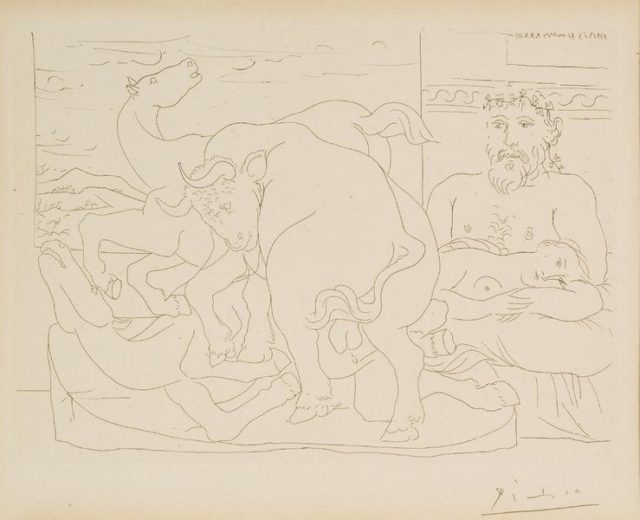I spent my Fall 2024 semester studying abroad in Madrid, Spain. I enrolled in courses held directly in Madrid’s world-renowned museums: the Prado and the Reina Sofía. While the Prado’s Renaissance and Baroque artworks left me speechless, the Reina Sofia holds a special place in my heart because it features works I had yet to study. My mother studied Spanish Modern Art in Barcelona during her junior year of college, so I grew up hearing her discussions of Dalí, Picasso, and Miró. The Reina Sofía allowed me to put faces and artworks to these unforgettable names.
Upon returning to campus, I was drawn to Pablo Picasso’s Le Repos du Sculpteur devant des Chevaux et un Taureau, an etching on paper from 1933 that is a part of our collection. Pablo Picasso (1881–1973) was a Spanish painter, sculptor, and co-founder of Cubism whose revolutionary approach to form and perspective reshaped modern art. Known for iconic works like Les Demoiselles d’Avignon and Guernica, Picasso experimented across styles and media, leaving behind a vast and diverse artistic legacy.
The title of this piece translates to “The Sculptor at Rest Before Horses and a Bull.” A woman appears to be resting on a man’s lap, where both figures look calm and at peace. This tranquility is juxtaposed by the chaos of the sculpture, which depicts a bull ramming into a horse as another horse lies painfully on the floor. We can see the base of the sculpture’s rough edges, illustrating how the work is still in progress. The sculpture seems to be placed in front of another painting or window. Though Picasso’s lines are quick and light, they remain deeply intentional, capturing the movement and calamity of the sculpture.

This piece immediately caught my eye because it reminded me of Picasso’s Guernica, from 1937. During my semester abroad, I spent hours standing in front of the giant mural, closely studying each detail. So, I was thrilled when I came across this etching in Davidson’s collection, connecting me back to my time in Spain. The sculpture Picasso sketches captures the same chaos as the iconic mural. The figures in both pieces are intertwined, making it difficult to see each form in its complete independence. Furthermore, the horse’s curved neck mimics that of the wailing women in Guernica. Despite the pieces’ different intentions, the etching holds stylistic similarities that foreshadow the iconic style that would define Guernica.

Discovering Le Repos du Sculpteur devant des Chevaux et un Taureau on my own campus not only brought me back to the Reina Sofía but also revealed the continuity in Picasso’s work—the quiet chaos, the layered emotion, the unmistakable style. It reminded me that art connects across time and place, always offering new meanings and memories.
– Sabrina Bonavita ’26

